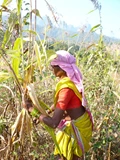
Nearly the entire population of Gaza, about 96 percent, is facing acute food insecurity, prompting a stark warning from the Food and Agriculture Organization (FAO) of the United Nations regarding an escalating famine risk amid ongoing conflict and limited humanitarian access. The latest Integrated Food Security Phase Classification (IPC) report underscores the dire and unpredictable conditions in the region.
Despite some improvements in Northern Gaza during the analysis period, the situation remains critical and volatile. FAO Chief Economist pointed out that intensified ground operations in Northern Gaza have led to significant displacement, worsening both social and food security conditions.
Almost the entire population of Gaza, approximately 96 percent, is currently experiencing acute food insecurity (IPC Phase 3 or higher). The situation is precarious, with a risk of pushing more individuals into catastrophic hunger levels if substantial increases in humanitarian aid do not occur. Presently, about 495,000 people, or 22 percent of the population, are in a state of catastrophic food insecurity (IPC Phase 5).
FAO's recent satellite data analysis shows extensive damage to agricultural land in Gaza, with over 57 percent of land affected as of May 2024. This includes damage to orchards (61 percent), vegetable fields (19 percent), and cereal crops (20 percent). The conflict has also severely impacted agricultural infrastructure, damaging greenhouses, wells, solar panels, and other facilities.
The agricultural sector, covering over 40 percent of Gaza's surface area and contributing significantly to daily consumption, has been destroyed. This has led to substantial income losses for household’s dependent on agriculture, with some experiencing up to a 72 percent drop in income. The Port of Gaza City has also been heavily damaged, affecting the fishing industry, and livestock numbers have sharply declined.
FAO, along with other humanitarian organizations, faces logistical challenges in delivering aid to Gaza. Despite these obstacles, FAO has distributed 500 tons of fodder, benefiting around 2,900 individuals. The organization is preparing additional food production inputs for transport to Gaza, contingent on access permissions.
In response to the crisis, the UN has launched a flash appeal for the occupied Palestinian territory, seeking $40 million, with $29 million allocated for Gaza and $11 million for the West Bank. This funding aims to provide emergency agricultural support, restock livestock, and supply critical inputs to farmers, helping over 70,000 individuals.
As the conflict continues, the FAO and other humanitarian actors are intensifying efforts to mitigate the impact on food security and support the recovery of Gaza's agricultural sector. The situation remains precarious, with urgent action needed to prevent a full-scale famine.
















